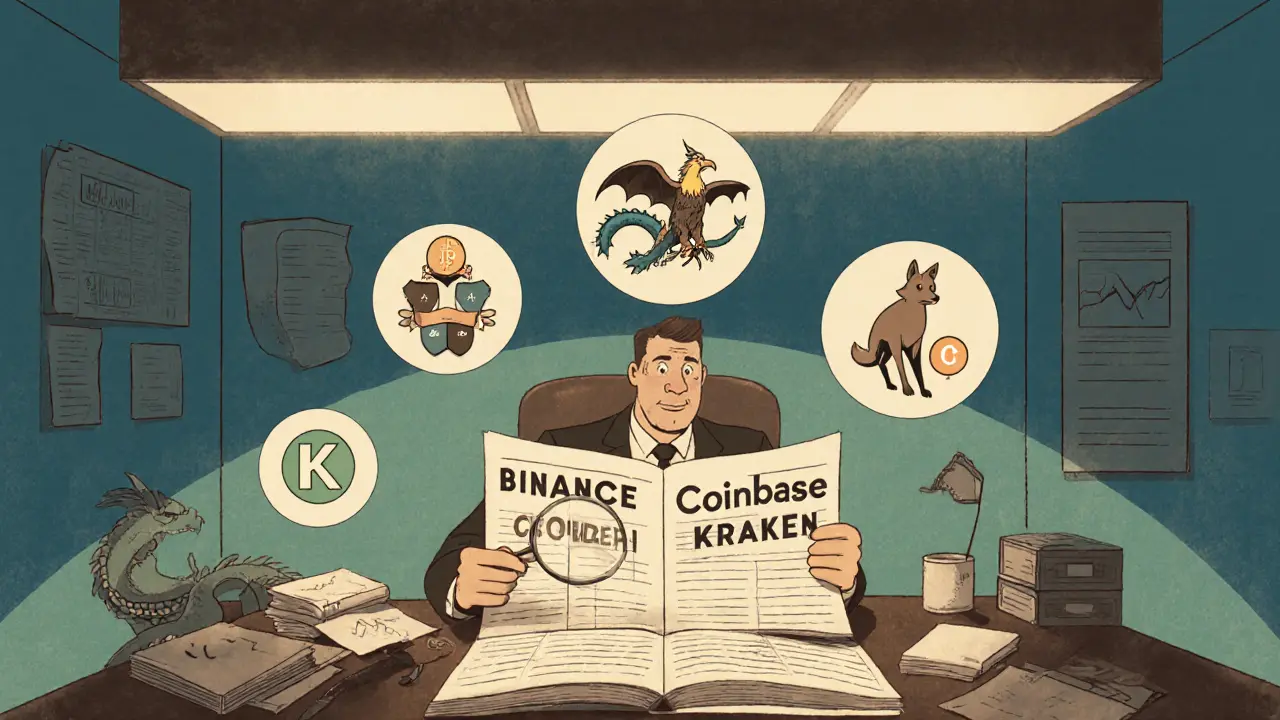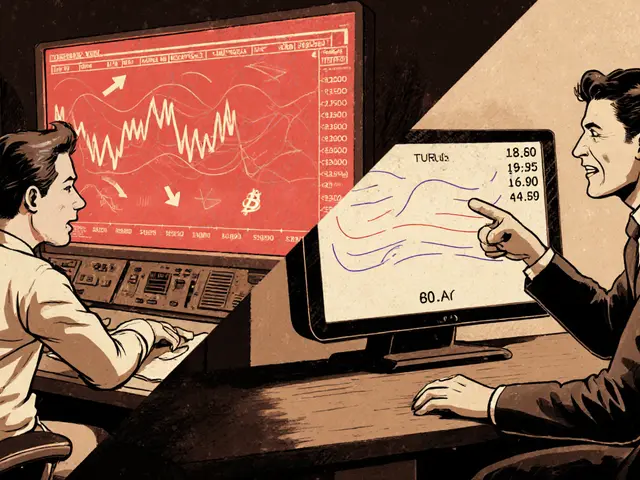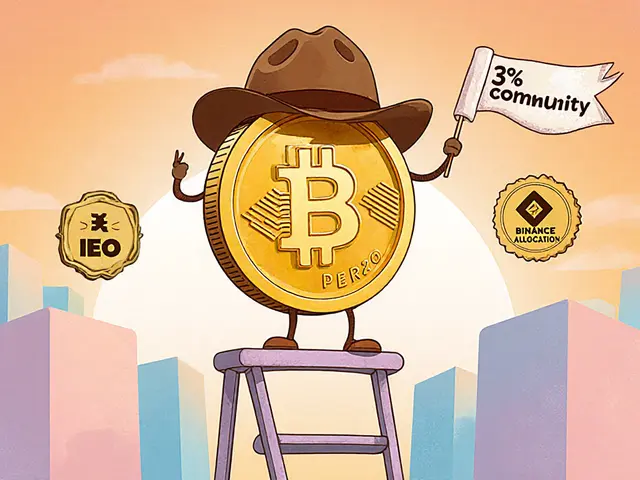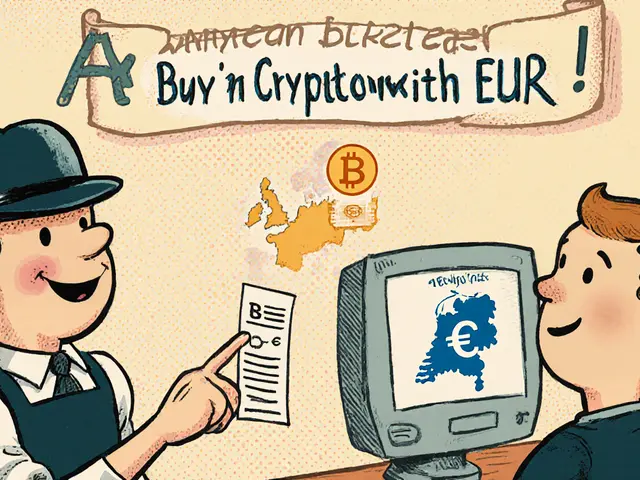
Crypto Exchange Fee Calculator
Your Trading Details
Why Fees Matter
The fee structure can significantly impact your profits, especially for high-frequency trading. Consider your trading volume and strategy when choosing an exchange.
Estimated Monthly Fees
Enter your trading details above to see estimated fees
Key Takeaways
- Binance leads spot volume but faces U.S. restrictions; Coinbase is best for beginners.
- Kraken offers deep liquidity and advanced tools for pro traders.
- Gemini stands out for regulatory compliance and custody insurance.
- OKX dominates derivatives trading with lower fees than most rivals.
- Security, regulation, and fee structure matter more than sheer volume.
When you type crypto exchange review into Google, you expect a clear picture of which platform actually delivers on its promises. In 2025 the market is crowded, heavily regulated, and split between massive global players and niche specialists. This guide walks you through the biggest exchanges, breaks down the numbers that matter, and helps you decide which one fits your trading style.
What Exactly Is a Cryptocurrency Exchange?
Cryptocurrency Exchange is a digital marketplace where users can buy, sell, and trade crypto assets. It acts as an intermediary, matching buyers with sellers and often providing tools like order books, wallets, and APIs. Exchanges differ in how they handle custody, regulation, fees, and the assets they list, so choosing the right one depends on your priorities.
How the Landscape Looked in 2025
The total tracked reserve across all exchanges hit about $1.8trillion in Q32025. Volume is no longer the sole indicator of quality; regulators in the U.S., EU, and Asia have forced platforms to tighten security, disclose reserves, and obtain licenses. As a result, the top five exchanges now excel in distinct categories rather than all‑around dominance.
Deep Dive into the Top Platforms
Below is a snapshot of the five most influential exchanges based on volume, fee structure, regulatory standing, and security reputation.
| Exchange | Q32025 Spot Volume (USD) | Typical Maker/Taker Fees | Regulatory Status | Security Rating* |
|---|---|---|---|---|
| Binance | $1.8trillion | 0.01%/0.10% | Global, but U.S. users must use Binance.US (restricted features) | 8/10 |
| Coinbase | $234billion (North America) | 0%/0.50% (varies by product) | NYDFS & SEC‑registered, U.S. focused | 9/10 |
| Kraken | $102billion | 0.16%/0.26% (Pro tier) | NYDFS‑compliant, EU MiCA licensed | 8.5/10 |
| Gemini | $68billion | 0%/0.35% | NYDFS‑regulated, insurance‑backed custody | 9.2/10 |
| OKX | $1.3trillion (derivatives) | 0.02%/0.07% | Licensed in Singapore, limited U.S. access | 8/10 |
*Security rating blends factors like cold‑storage usage, insurance coverage, and past breach history. Scores are compiled from CoinGecko Trust Score and independent audits.

Why Volume Isn’t Everything
Binance processes the most trades, but if you’re a U.S. resident you’ll hit a wall with limited features and higher compliance hurdles. Kraken, while smaller, consistently ranks top for order‑book depth and execution speed-critical for day traders. Gemini’s regulatory shield matters for institutions that can’t risk a custodial loss. OKX’s dominance in derivatives gives it an edge for futures enthusiasts, yet its compliance gaps keep it out of some jurisdictions.
Fees: The Hidden Cost of Trading
Fees can erode profits, especially on high‑frequency strategies. Here’s a quick rule of thumb:
- Maker‑taker spreads under 0.1% are “low‑fee” tier.
- Flat‑fee platforms (e.g., Robinhood Crypto) look attractive but often limit the coin list.
- Instant‑buy services (Coinbase Instant) may charge up to 4%-best kept for small, occasional purchases.
When you calculate your expected monthly turnover, multiply the projected volume by the taker fee and compare it to the “fee rebate” programs many exchanges offer for holding native tokens.
Security and Regulation: Peace of Mind
From 2023 onward, regulators have forced exchanges to:
- Maintain audited reserve statements.
- Implement mandatory two‑factor authentication (2FA).
- Obtain a license or charter from local authorities (NYDFS, MiCA, FSC).
Gemini and Coinbase publish quarterly proof‑of‑reserves reports, making them the safest bets for institutional users. Kraken recently rolled out ZK‑Rollup proof‑of‑liquidity, a cutting‑edge privacy feature that also cuts settlement times.

Choosing the Right Exchange for Your Style
Match your priorities against the matrix below:
- Beginner, hands‑off learning: Coinbase - intuitive UI, abundant tutorials, but expect higher fees.
- Intermediate with occasional derivatives: Kraken - solid spot market, decent futures, advanced charting.
- Professional day trader: Binance (global) or OKX - deepest liquidity, lowest fees, extensive API support.
- Institutional or security‑focused: Gemini - regulatory coverage, insurance‑backed custody, compliance reports.
- DeFi enthusiast: Uniswap or dYdX - non‑custodial, but watch gas fees and liquidity depth.
Practical Steps to Get Started
- Pick the exchange that aligns with your risk tolerance and regulatory needs.
- Complete KYC verification - most platforms finish in under 24hours, though Kraken can take up to 5days for high‑value accounts.
- Enable 2FA and, where available, hardware‑based security keys.
- Deposit a small test amount (often $10‑$50) to familiarize yourself with the order interface.
- Gradually scale up, monitoring fee tiers and order execution speed.
For most users, the whole onboarding process takes 2‑3hours on Coinbase or Gemini, but expect a longer learning curve on Binance’s advanced dashboard.
Future Outlook: What’s Next for Exchanges?
Regulation will keep tightening. By 2026, analysts predict U.S.‑registered exchanges will control roughly 65% of institutional volume. Expect more on‑chain auditing tools, wider adoption of zero‑knowledge proofs, and a wave of consolidation-Gartner forecasts 30% of current platforms will merge or exit by 2027.
Keep an eye on newer entrants that comply with MiCA and the growing demand for “green” crypto trading platforms that offset their electricity usage.
Frequently Asked Questions
Which exchange has the lowest fees for high‑frequency traders?
Binance and OKX both offer sub‑0.02% taker fees for volume above $10million per month. If you also hold their native tokens (BNB or OKB), you can unlock additional rebates, pushing effective fees below 0.01%.
Is it safe to keep my crypto on an exchange?
Exchanges with regulatory licenses-Coinbase, Gemini, Kraken, and the EU‑MiCA‑compliant platforms-store the majority of assets in cold storage and carry insurance for custodial losses. For maximum safety, keep only what you need for trading and store the rest in a hardware wallet.
Can I trade derivatives on Coinbase?
Coinbase launched a limited futures product for Bitcoin and Ethereum, but the volume and variety are far smaller than OKX or Bybit. If derivatives are core to your strategy, look to a dedicated platform like OKX.
How long does KYC verification usually take?
Most U.S. exchanges (Coinbase, Gemini, Kraken) verify within minutes to a few hours for standard accounts. Complex corporate or high‑value accounts can take up to 5business days.
Are decentralized exchanges (DEXs) a good alternative?
DEXs like Uniswap and dYdX give you full custody and no KYC, but they suffer from higher gas fees and lower liquidity. They’re great for swaps of popular tokens, but for large trades you’ll likely face slippage.





Comments (18)
Michael Grima
Wow, because we totally needed another exhaustive list of fees to brighten our day.
Mandy Hawks
When you strip away the hype, the true measure is how an exchange aligns with one’s personal risk appetite and regulatory comfort; volume alone is a siren song that can lead you astray.
Scott G
It is imperative for investors to conduct a comprehensive due‑diligence exercise, taking into consideration not only the fee schedule but also the custodial safeguards, audit transparency, and jurisdictional licensing of the platform in question.
VEL MURUGAN
Security is the cornerstone of any respectable exchange, and overlooking it is tantamount to inviting disaster.
Regulators have forced platforms to publish audited reserve statements, a move that improves transparency.
Gemini leads the pack with NYDFS oversight and a fully insured custody solution.
Coinbase follows closely, offering quarterly proof‑of‑reserves that can be independently verified.
Binance, while dominant in volume, still grapples with jurisdictional challenges in the United States.
Kraken’s recent implementation of ZK‑Rollup proof‑of‑liquidity not only boosts privacy but also accelerates settlement times.
OKX’s lower derivative fees are attractive, yet its limited U.S. access warrants caution for American traders.
When evaluating fee structures, remember that maker‑taker spreads under 0.1 % are generally considered low‑fee.
High‑frequency traders should also factor in rebate programs tied to native token holdings.
For beginners, the intuitive UI of Coinbase outweighs its higher taker fees, whereas institutions may prioritize Gemini’s insurance.
Liquidity depth is crucial for day‑trading; Kraken consistently offers tight order‑book spreads.
Cold‑storage ratios vary, but top exchanges keep upwards of 95 % of assets offline.
Two‑factor authentication is now mandatory across the board, reducing the attack surface for phishing.
Hardware security keys add an extra layer of protection and are recommended for large balances.
In summary, a balanced approach-considering security, regulation, and fee efficiency-will serve most traders best.
Russel Sayson
If you’re chasing razor‑thin spreads and lightning‑fast execution, Kraken’s professional tier gives you the depth and tools that casual platforms simply can’t match.
Michael Bagryantsev
Take a moment to map out your trading goals, then pick the exchange whose features most closely mirror those objectives; a patient approach often saves more than a hasty one.
Maria Rita
Remember, starting small on a user‑friendly platform like Coinbase can boost confidence, and the tutorials there make the learning curve feel like a gentle slope rather than a cliff.
Jordann Vierii
From a global perspective, the diversity of exchange offerings means traders can specialize – whether you crave deep liquidity, low fees, or robust compliance, there’s a niche waiting.
Lesley DeBow
In the grand tapestry of finance, each exchange is a thread; pull the right one and you weave a sturdier net for your assets. 😊
DeAnna Greenhaw
One must acknowledge that the hierarchy of exchanges, while ostensibly dictated by volume, is in fact a nuanced stratification predicated upon regulatory fidelity, custodial assurance, and fee elasticity, each factor inexorably sculpting the investor’s fiduciary calculus.
Luke L
Patriotic investors should rally behind American‑regulated platforms; supporting domestic compliance fortifies our financial sovereignty.
Cynthia Chiang
its really importnt to double chekc the security rating of any platform before committing funds; a tiny oversight can lead to big losses.
Hari Chamlagai
Honestly, if you haven't read the latest audit report from Gemini, you're missing the most critical piece of the puzzle; their insurance-backed custody is unparalleled, and the numbers speak for themselves.
Ben Johnson
Looks like everybody’s busy naming the “best” exchange while forgetting the simple truth: use what you actually understand.
Jason Clark
Sure, Binance’s depth is impressive, but the hidden compliance costs for U.S. users often turn the apparent advantage into a bureaucratic nightmare.
Jim Greene
Stay positive, keep learning, and remember that every small trade builds experience – you got this! 🚀👍
Della Amalya
In the theater of crypto, the spotlight often shines on flashier platforms, but the unsung heroes-those that quietly protect your assets-deserve a standing ovation.
Isabelle Graf
Another list, another headache.